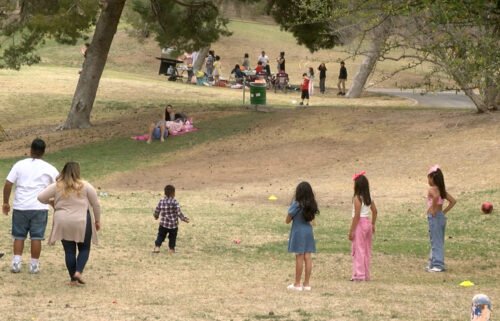Easter dishes from around the world
Honey-glazed ham, garlic mashed potatoes and fluffy dinner rolls might be staples at American Easter meals, but around the world, there are many distinct ways to savor the holiday — ones that incorporate both local ingredients and unique cultural traditions.
“Italians go all out,” said Judy Witts Francini, creator of the Italian food blog Divina Cucina. She’s from California but has lived in Florence and Tuscany for decades.
Witts Francini’s Easter lunch starts with an assortment of antipasti. For the first course, she serves a savory tart called torta pasqualina, which has 33 layers of phyllo dough to symbolize the 33 years of Christ’s life. The second course includes roast lamb, fried artichokes, peas with pancetta and roasted potatoes. Dessert is chocolate eggs (which can be up to 3 feet tall) with a gift inside and a dove-shaped cake, called colomba.
And that’s just lunch.
Other countries take a similar “more is more” approach to Easter meals, but a few dishes really stand out. Here are just five.
Italy: Pizza rustica
Before you roll your eyes at the mere mention of this circular classic, know that the pizza Italians crave on Easter bears little resemblance to what you find on most US delivery menus.
Pizza rustica, also known as pizzagaina, is stuffed with meat and cheese and enclosed in a flaky crust. Like most Italian recipes, pizza rustica varies from region to region, town to town and chef to chef. It originally comes from Naples, which is known as the birthplace of pizza.
“It’s basically a ricotta cheesecake, but it’s super savory — to the max,” said Rossella Rago, an Italian American author and host of the popular online cooking show “Cooking with Nonna” who wrote a cookbook with the same name.
To make the pie, first, you need to make the pastry dough, which includes flour, eggs, salt, milk and lard.
“Everybody always asks me, ‘Can I make this with shortening?’ And the answer is always: ‘No,'” Rago said. “If it’s any other time of year, I will say, ‘Yes, fine, use shortening,’ but when it’s actually Easter you have got to use lard.”
Inside, the pizza — at least Rago’s version — contains ricotta, provolone, mozzarella, soppressata (an Italian dry salami), prosciutto, eggs and more.
“Everybody has their own combination that they swear by. If you want Italian people to fight right now, ask them, ‘What’s the real pizzagaina?’ That’s what everybody is obsessed with in Italian America,” Rago said. “It makes me laugh every single time, because there is no right way. It’s ridiculous to think that.
“Italy had 600 languages until its unification,” Rago added. “So, you think we have one recipe for anything, absolutely not.”
Rago’s recipe is from her grandma, Nonna Romana, and is a true Italian American story. Romana is from Puglia, a region in southern Italy where they don’t make the dish. She learned about it from other Italian Americans while she was working at a clothing factory in Brooklyn, New York. She took their version and made some additions and subtractions. After years and years of tweaks, she created her own Italian American tradition.
“She swears it’s the best,” Rago said. Her secret is extra-sharp provolone. Rago said it’s one of the most popular dishes on her website, and everyone who tries it says they have success their first try.
Traditionally, this dish is made on Good Friday and served at room temperature on Easter Sunday.
Mexico: Capirotada
When you think of authentic Mexican cuisine, there are many things that come to mind: rice, beans and tortillas, to name a few.
Now, you can add capirotada to the list.
Capirotada is a Mexican dessert that’s similar to bread pudding. It’s made from bread drenched in syrup and layered among nuts, cheese, fruit and sometimes sprinkles.
“If you are into salty, sweet, soft, crunchy, spongy mixed all together with a dash of spice, this is for you,” said Mely Martinez, creator of the blog Mexico in My Kitchen. “Yes, this concoction sounds really weird, but it is an explosion of flavors in your mouth.”
Martinez was born and raised in Tampico, Mexico. She serves this dish for dessert every Easter.
To make Martinez’s traditional capirotada, layers of sliced white bread are baked with butter and then dipped in syrup made from piloncillo (an unrefined type of sugar), cinnamon and cloves. The bread is placed in a ovenproof dish between layers of cotija cheese, roasted peanuts and raisins. It’s baked and then topped with bananas and sprinkles.
Capirotada is usually served at room temperature on Easter Sunday, but many serve it throughout Holy Week.
“It’s addicting. Once you start eating it, you can’t stop eating it,” Martinez told CNN.
Brought to Mexico by the Spaniards, capirotada became popular in Mexico because it’s easy to make and uses ingredients people have on hand.
It was originally a savory dish using beef broth, but evolved into today’s sweet version using syrup, according to Martinez. Some believe the bread represents the body of Christ and the syrup represents his blood.
There are many variations of capirotada all over Mexico.
My Latina Table blogger Charbel Barker makes hers with milk. Her recipe was created by her “abuelita,” meaning grandma.
“My abuelita would always say, it’s good but something is missing. It needs more sweetness,” Barker said. So she added two types of milk: evaporated milk and sweetened condensed milk.
Barker said the milk adds more flavor and creates a pudding-like texture.
“It tastes like a Snickers,” Barker said.
Poland: Żurek
In Poland, a dish that takes center stage on Easter is żurek. It’s a creamy and smoky fermented soup made from rye flour starter. This soup is often served with a boiled egg and sausage, and then garnished with spicy horseradish.
Żurek is regarded as something of a national treasure in the Central European country.
“It’s sour, tangy and meaty,” said Anna Hurning, the creator of the blog Polish Your Kitchen. Hurning was born and raised in Poland and now lives in the city of Szczecin.
She makes żurek every Easter and serves it as an appetizer.
To make the soup, first, you need to make a rye starter: Mix flour and cold water with aromatics (including garlic, allspice, peppercorns, marjoram and bay leaves). Then, let it sit on your counter for several days to ferment. Hurning said this is how it gets its “funky” flavor. Don’t be intimated by this step — she said it’s supereasy. You just let nature do the trick.
Next, the sour starter is boiled with the soup base. Hurning’s version consists of bacon, carrots, parsnip and onion.
This soup is served all over the country year-round and on Easter with many variations. Some have it with sauerkraut and smoked goat cheese. Others add potatoes and wild mushrooms.
Singapore: Beef murtabak
The cuisine in Singapore is truly a mélange of cultures: Chinese, Malay, Indian, Eurasian and Peranakan. Pinpointing dishes authentic to Singapore might seem like an impossible feat, but that’s exactly the endeavor chef Damian D’Silva has chosen.
“If I don’t do anything to preserve the cuisine of our heritage, one day it will all disappear,” said D’Silva, the head chef at Restaurant Kin in Singapore. He has been cooking heritage cuisine professionally for more than 20 years.
“The cuisine is very unique. You can have one dish in Singapore, but you have five different ways of preparing it,” he said. “And no one is wrong because every ethnicity puts in their own story and ingredients.”
D’Silva grew up in Singapore, and one of his childhood favorites was beef murtabak. His granddad made it on Easter and served it after Mass — marking the end of Lent. D’Silva remembers looking forward to the savory dish after going 40 days without meat.
“When Easter happened, it was a celebration and, of course when it’s a celebration, the thing that comes to mind is meat,” he said. “We only ate beef on very, very special occasions.”
Beef murtabak is an egg crepe wrapped around ground beef. The beef is marinated in curry powder, then cooked with an onion and garlic paste and spices (star anise, cinnamon and nutmeg). The dish is served with fresh lime, chili sauce and raita.
“The aromatics are the one that lifts the entire dish and bring it to another level,” D’Silva said.
D’Silva has tried to find the origin of the dish. But like many Singaporean dishes, it goes so far back that nobody knows where it started.
This Easter, D’Silva is making beef murtabak at Restaurant Kin to celebrate Singapore’s heritage.
“Singapore is a lot more than chili crab and chicken rice. It’s a lot, lot more than that,” D’Silva said. “If you have an opportunity to go to a restaurant that serves Singapore’s heritage cuisine, go, because it’s mind-blowing: the flavor, the ingredients. Everything about it.”
Nigeria: Jollof rice
Loud, large and plentiful — that’s how Lola Osinkolu, who’s behind the blog Chef Lola’s Kitchen, describes Easter in Nigeria.
Osinkolu, who was born and raised in Nigeria, said after church Easter Sunday morning, her family would go home and start cooking.
“We cook, cook and cook. We would cook for hours.”
The dish that was the star of show: Nigerian jollof rice.
Osinkolu compares the tomato-based rice dish — which likely originated in Senegal and spread to West African countries — to jambalaya. It’s a party staple in Nigeria.
“It’s spicy and delicious,” she said.
Jollof contains long-grain rice and Nigerian-style curry powder for seasoning, and there are many ways to cook the dish that involve endless permutations of meat, spices, chiles, onions and vegetables.
Osinkolu’s recipe, called The Party Style With Beef, comes from her mom. But Osinkolu added her own secret step: roasting the bell peppers, tomatoes, onion and garlic.
“At home, whenever we are having parties, we don’t cook our jollof rice on the stovetop. We use open fire, so the jollof rice has a smoky taste, which makes it more delicious,” Osinkolu said. “So, I roast the bell peppers to achieve a similar, or very close, taste. It makes a lot of difference.”
This year, Osinkolu’s Easter version will include goat meat and chicken. Her jollof is so popular that she now knows to always make extra for her guests to take home.
“I get the same comment over and over about how delicious it is,” she said.




